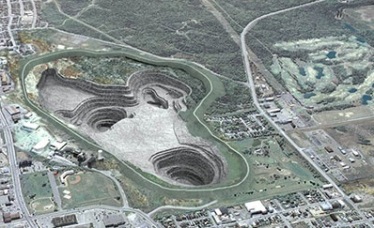Mining operations Porcupine is located in Timmins, Ontario, one of the
world’s great gold producing camps. Located within the city limits of
Timmins, Ontario, the Porcupine complex includes approximately 38,000
hectares of mining claims. Paved-road access is readily available, as
the principal properties. The Porcupine mines consist of ultramafic and
mafic volcanic rocks of the Keewatin subgroup overlain by sedimentary
rocks of the Timiskaming group. The lands lie adjacent and to the north
of the regionally significant Porcupine Destor Fault. Gold
mineralization is found in a number of different structural settings and
consists of continuous quartz carbonate veins, quartz tourmaline veins,
quartz stockworks and gold associated with disseminated sulphides.
Porcupine mining consists of the
Hoyle Pond and Dome underground mines, the Hollinger open pit mine,
several large tonnage stockpiles, and a central milling facility.
Progress is steadily advancing on a deep underground shaft (winze) that
will provide increased access to zones such as the TVZ and VAZ in the
underground Hoyle Pond mine operation and significantly extend the
mine’s productive life.
Methods of gold mining operations
Porcupine, exploration drilling at underground. The Hoyle has
demonstrated improving gold grades and the extension of several gold
structures at depth. This success is spurring new investments in mine
development to position the revitalized Porcupine mine complex for
long-term success.
The
Hoyle Pond underground mine is accessed by decline and by a shaft. The
current winze configuration has the potential for expansion to access
below 2,000 metres. Mining methods employed are conventional cut and
fill, shrinkage, panel mining and longhole methods in wider zones.
Gold is recovered using a
combination of gravity concentration and cyanidation techniques. The
circuit consists of primary, secondary and tertiary crushing, rod/ball
mill grinding, gravity concentration, cyanide leaching, carbon-in-pulp
gold recovery, stripping, electro winning and refining.
 The Hollinger open pit is located in the City of Timmins adjacent to
residents and businesses. The pit will reclaim 250 acres of currently
unusable and unsafe land for future safe public use. All permits have
been received following a period of public consultation and the
installation of a monitoring system ensuring the pit can meet the Best
Management Plan, signed with the City of Timmins, and the Ministry of
Environment’s noise, air and vibration guideline limits. Site stripping
and mining activities currently take place during the day until the
Environmental Control Berm is constructed around the pit periphery. The
berm is designed to reduce noise levels and once complete, fulltime 24
hour operations will commence.
The Hollinger open pit is located in the City of Timmins adjacent to
residents and businesses. The pit will reclaim 250 acres of currently
unusable and unsafe land for future safe public use. All permits have
been received following a period of public consultation and the
installation of a monitoring system ensuring the pit can meet the Best
Management Plan, signed with the City of Timmins, and the Ministry of
Environment’s noise, air and vibration guideline limits. Site stripping
and mining activities currently take place during the day until the
Environmental Control Berm is constructed around the pit periphery. The
berm is designed to reduce noise levels and once complete, fulltime 24
hour operations will commence.
In 2015, Porcupine marked its 105
th year of continuous mine and mill operations and has produced more
than 67 million ounces of gold since production began. In 2014 gold
production totaled 300,000 ounces. Production during 2015 is expected to
be between 300,000 and 320,000 ounces.






